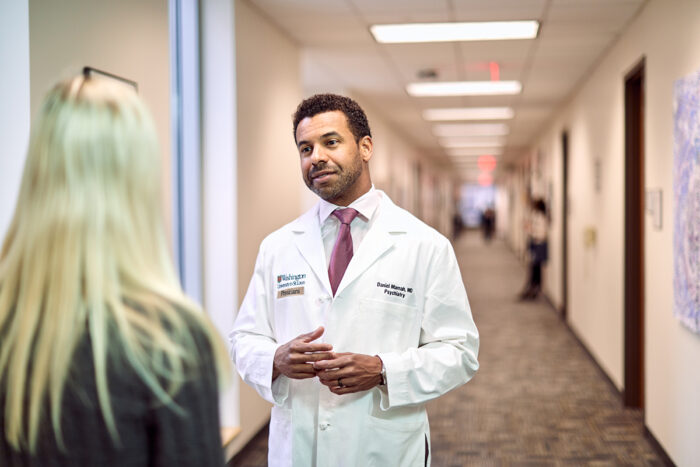WashU part of $65 million NIH study of schizophrenia in young people
Teens, young adults needed for study aimed at improving early diagnosis
 Matt Miller
Matt MillerDaniel Mamah, MD, of Washington University School of Medicine in St. Louis, has received a grant as part of an international study focused on young people at high risk of schizophrenia. Mamah and his colleagues plan to characterize symptoms that can help diagnose schizophrenia early, as well as identify biomarkers in the blood and brain that may help predict risk.
Washington University School of Medicine in St. Louis is part of a major international study aimed at identifying causes and effects of the early stages of schizophrenia in young people, with the goal of improving early diagnosis and treatment.
The mental illness is characterized by alterations in thoughts, feelings and behaviors, which may include psychosis, a loss of contact with reality.
By studying young people at high risk of schizophrenia, the researchers plan to characterize the variety of symptoms that can help diagnose schizophrenia early, as well as identify biomarkers in the blood and brain that may help predict risk. Such information could help identify drug targets that have potential for treating schizophrenia early or even preventing problems, such as disordered thinking, that are associated with the disease.
For the study, the researchers are seeking adolescent and young adult volunteers, ages 12 to 30, who have experienced symptoms of psychosis — such as hallucinations, delusions or intrusive disturbing thoughts — suggesting they may be at risk for developing schizophrenia.
“About 100,000 young people in the United States experience a first episode of psychosis every year, and over 1 million children and adolescents experience other problems in perception, thinking, mood and social functioning that put them at risk for schizophrenia,” said Daniel Mamah, MD, an associate professor of psychiatry and the lead investigator at the Washington University clinical site. “Those problems tend to get worse over time, especially when untreated, so the goal here is to identify problems at the earliest possible stage.”
The Psychosis-Risk Outcomes Network (ProNET) study is funded by a grant of more than $65 million from the National Institute of Mental Health of the National Institutes of Health (NIH). Overall, the study will recruit 1,040 young people at high risk of schizophrenia at 26 sites around the world. There are 18 U.S. sites, with other sites in Canada, the United Kingdom, Italy, Spain, Germany, China and South Korea. About 50 patients will be enrolled in the study at the Washington University site.
The grant is a component of an NIH public-private partnership designed to meet the urgent need for early therapeutic interventions for people at high risk of developing schizophrenia. The effort brings together the NIH, the Food and Drug Administration, and a number of nonprofit and private universities and other organizations, including Washington University.
The groups involved are working toward the shared mission of discovering promising biological markers to help identify those at high risk for schizophrenia as early as possible, track the progression of their symptoms and other outcomes, and identify targets for treatment.
Schizophrenia is one of the leading causes of disability worldwide, but it often goes undiagnosed until symptoms have become disruptive in a person’s life. Treatment delays can be associated with long-term problems, such as alcohol and drug abuse, difficulty holding a job and homelessness.
“Just being at high risk of schizophrenia is increasingly recognized as a public health problem that affects adolescents and young adults,” Mamah said. “To develop more effective therapies, we must characterize the substantial variations of symptoms among those at risk, as well as untangle the roots of those differences.”
Many experts think that by detecting schizophrenia earlier and starting treatment sooner, it may be possible to relieve, postpone or even prevent some of the long-term difficulties associated with the disorder.
“Often, when doctors first see young patients who may have experienced a psychotic episode, it’s not possible to know whether they are on the path to more serious problems, partly because the early symptoms of schizophrenia can vary so much between individuals,” Mamah said. “By studying brain structure and function, psychopathology and cognition, genetics, behavior and other factors, this project is designed to identify patients at high risk so that when we have available treatments, they can begin receiving those treatments more quickly.”
Mamah is director of the Washington Early Recognition Center, a Washington University clinic that treats young people experiencing the earliest signs of mental illness involving psychosis and those in early stages of psychotic disorders, such as schizophrenia and some forms of bipolar disorder.
The study is enrolling young people who may be at risk for schizophrenia after experiencing an episode of psychosis or other symptoms — for example, a young person who previously was outgoing but suddenly becomes more introverted and withdrawn, who stops doing as well in school as in the past, or who begins to behave in a suspicious or paranoid manner or seems to respond to voices that no one else hears.
Young people experiencing such symptoms can be referred by doctors, parents or teachers who worry that the adolescent or young adult may be developing problems. Those under 18 must have a parent’s or guardian’s consent to participate in the study. Young men and women over age 18 who think they may qualify can refer themselves to the study. A short screening on the group’s website gives young people the option to provide information if they might be interested in clinical services or in participating in the study.
Researchers will follow study volunteers for two years, assessing genetic and clinical biomarkers that may be linked to hallucinations or intrusive thoughts. The researchers also will conduct imaging studies of brain structure and function and collect blood and saliva samples. In addition, subjects will be assessed for psychopathology, language, speech and cognitive ability.
For more information about the study, call Carli Ryan at 314-362-5216, e-mail carli.ryan@wustl.edu, or visit the clinic’s website.






